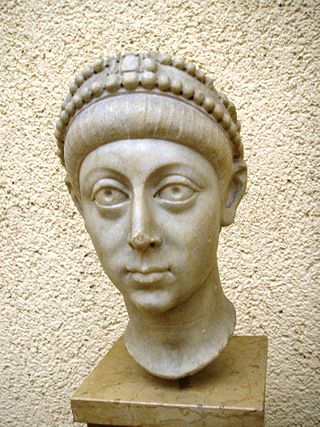
Arcadius was Roman emperor from 383 to his death in 408. He was the eldest son of the Augustus Theodosius I and his first wife Aelia Flaccilla, and the brother of Honorius. Arcadius ruled the eastern half of the empire from 395, when their father died, while Honorius ruled the west. A weak ruler, his reign was dominated by a series of powerful ministers and by his wife, Aelia Eudoxia.

Pope Siricius was the bishop of Rome from December 384 to his death. In response to inquiries from Bishop Himerius of Tarragona, Siricius issued the Directa decretal, containing decrees of baptism, church discipline and other matters. His are the oldest completely preserved papal decretals. He is sometimes said to have been the first bishop of Rome to call himself pope.
The 400s decade ran from January 1, 400, to December 31, 409.
The 380s decade ran from January 1, 380, to December 31, 389.
The 430s decade ran from January 1, 430, to December 31, 439.
The 420s decade ran from January 1, 420, to December 31, 429.
The 270s decade ran from January 1, 270, to December 31, 279.

Year 401 (CDI) was a common year starting on Tuesday of the Julian calendar. At the time, it was known as the Year of the Consulship of Vincentius and Fravitus. The denomination 401 for this year has been used since the early medieval period, when the Anno Domini calendar era became the prevalent method in Europe for naming years.
The 390s decade ran from January 1, 390 to December 31, 399
The 340s decade ran from January 1, 340, to December 31, 349.
The 350s decade ran from January 1, 350, to December 31, 359.
The 280's decade ran from January 1, 280, to December 31, 289.

Year 384 (CCCLXXXIV) was a leap year starting on Monday of the Julian calendar. At the time, it was known as the Year of the Consulship of Ricomer and Clearchus. The denomination 384 for this year has been used since the early medieval period, when the Anno Domini calendar era became the prevalent method in Europe for giving names to years.

Year 280 (CCLXXX) was a leap year starting on Thursday of the Julian calendar. At the time, it was known as the Year of the Consulship of Messalla and Gratus. The denomination 280 for this year has been used since the early medieval period, when the Anno Domini calendar era became the prevalent method in Europe for naming years.
Eutropius was a fourth-century Eastern Roman official who rose to prominence during the reign of emperor Arcadius. He was the first eunuch to become a consul in the Roman Empire.
Gainas was a Gothic leader who served the Eastern Roman Empire as magister militum during the reigns of Theodosius I and Arcadius.
Tribigild, also called Tarbigilus was an Ostrogothic general whose rebellion against the Eastern Roman Empire precipitated a major political crisis during the reign of Emperor Arcadius.
Aurelianus was a prominent politician of the Eastern Roman Empire. He was praefectus urbi of Constantinople from 393 to 394, Praetorian prefect of the East from 399 to 400, and consul in 400. In 400, Gothic rebels under Gainas forced the emperor Arcadius to give them Aurelianus, and he was exiled; he returned to Constantinople after the defeat of the Goths later that year. He served as Pretorian Prefect to the East a second time from 414 to 416.

The Sassanid Empire or Sassanian Dynasty is the name used for the Persian dynasty which lasted from 224 to 651 AD.

The Gothic Revolt of Tribigild was a revolt in 399-400 of the Goths in Anatolia that caused a major political crisis during the reign of Emperor Arcadius (395-408). The uprising was led by Tribigild, leader of a unit of Goths within the Roman army. Initially, the uprising only took place in Anatolia, but after the commander-in-chief of the Eastern Roman army Gainas intervened and sided with the Goths, it became a threat to the unity within the Eastern empire.







